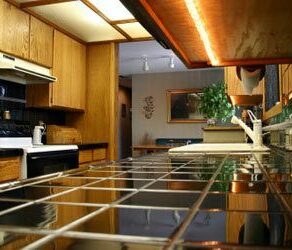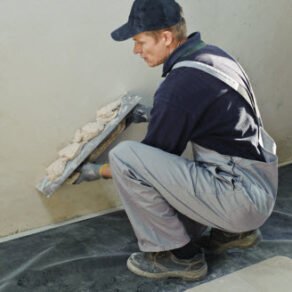
Orlando asked: How do I clean plaster of Paris from a cement floor? I was working on a crafts project and my cement floor got some plaster of Paris on it.
Plaster of Paris is a form of calcium sulphate that forms a liquid when added to water and hardens over time. Once it has hardened, it will require a solvent to dissolve it to remove it. Cement offers a solid workspace that can tolerate the cleaners that will dissolve the plaster of Paris. Follow these steps to dissolve the plaster so it can be scraped away.
You Will Need:
- Acid (choose one):
- Citric acid
- Vinegar
- Lemon juice
- Muriatic acid
- Plastic sheets (large enough to cover the plaster)
- Wide tape
- Water
- Biz powdered bleach
- Soft cloths
- Scraper
- Hammer (optional)
- Vacuum
Steps to Remove the Plaster
*When working with acid-based removers, always use caution and wear gloves and protective eyewear for your safety. Test a small area first to ensure that there are no adverse effects to the cement.
- Begin by cleaning the area. Vacuum away any dust and dirt so you have a clean area to work with.
- If the plaster is on a smooth concrete surface, you may be able to carefully break it up by tapping it with a hammer. This will provide an edge to use the scraper to lift even more. Remove as much as possible and then proceed to dissolving the rest.
- Choose a dissolving agent. Many of these you may already have in your home. Muriatic acid is the strongest and requires the most precautions. It is commonly found with the grout cleaners at home improvement and hardware stores.
- While all of these acids will dissolve the plaster, it will take a good amount of time to do so – sometimes a couple of days. The challenge is to keep the acid moist so it can keep interacting with the plaster to soften it.
- To accomplish this, get a soft cloth sopping wet with the acid and lay it on top of the plaster.
- Cover the entire area with plastic and tape the edges down. This will keep the moisture locked in so it doesn’t evaporate while it is working.
- Check it each day and scrape away any loosened plaster.
- Remoisten the cloth and reseal it under the plastic.
- Repeat this process until all of the plaster is removed.
Additional Tips and Ideas
- Plaster of Paris dries hard, but does wear down over time. If it is exposed to the changes of weather, it will wear even faster.
- If you can soak the plaster in water, it will dissolve over a longer period of time. Mix in Biz powdered bleach to expedite the process.









The recommendations here of how to dissolve or remove plaster of Paris are completely wrong, but is only information borrowed from other sites on the internet where they really don’t have clue either. I finally discovered the simple answer through extensive experiments.
I did lots of experiments with all kinds of acids, both diluted and concentrate, under many conditions and determined that acids DO NOT dissolve plaster of Paris in any way, but sometimes make it harder.
The chemicals which dissolve plaster of Paris are on the basic end of the pH scale, not acid. I first had some success with potassium cyanide, but what really worked better than anything is sodium bicarbonate. Makes sense. The sodium in baking soda hooks up with sulfur in the plaster, and the carbon hooks up with the calcium in the plaster.
TO BEST DISSOLVE PLASTER OF PARIS, PLACE IT IN WARM WATER WITH LOTS OF BAKING SODA.
Don’t use any acids or it will only defeat the process.
Now, what really amazes me is that the answer is so simple and safe, and surely some people must know it, but it apparently cannot be found on the internet, until now.
Daniel, thank you for your experiment and comment. It made sense, as plaster is CaSO4. I tried the baking soda solution; it loosened most of the plaster (stuck on CAT5 cables) within eight hours!
Nice; I’ll try it at my job. Sounds good.
Regards.
Baking soda & warm water. I have an antique vase that someone put plaster of Paris into the bottom of it; I guess so it wouldn’t tip over when flowers were added. I’ve tried everything, but didn’t try this one. I’m headed to the kitchen to get the baking soda right now. Thank you.
That was a very good presentation.
I tried baking soda and hot water to remove plaster of paris from the pot I had used to mix it. I usually don’t comment, but after trying this I’m actually compelled to. It worked quite well at softening up the plaster enough to remove it very easily. No chiseling, no banging; just a simple gentle flexing of the pot after stirring the water and baking soda for a few minutes.
How to remove plaster of Paris from a cement idol?
Udayanath,
The methods are the same for 3D items as for flat, just skip step 2. Good luck!